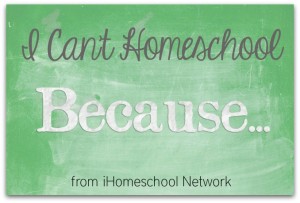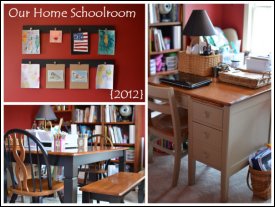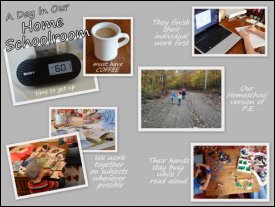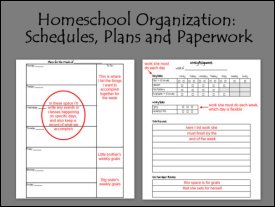 Hi, I'm Heidi and I homeschool my two sweet kids. I want them to know that learning is an exciting lifelong adventure! We love great books, unit studies, notebooking, lapbooking, and hands-on learning.
Hi, I'm Heidi and I homeschool my two sweet kids. I want them to know that learning is an exciting lifelong adventure! We love great books, unit studies, notebooking, lapbooking, and hands-on learning.The Pros and Cons of Homeschool Standardized Testing
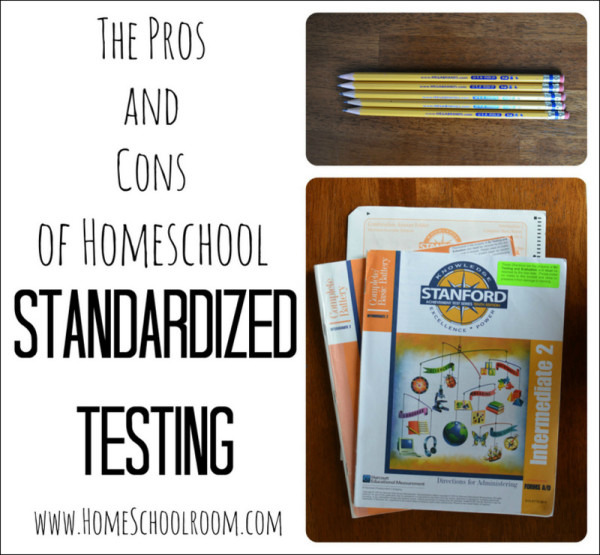
This was our last week of full-time school before we slide (or jump excitedly) into our relaxed summer school schedule. So that meant completing standardized tests this week. In Maine we have two options for fulfilling our state homeschool requirements: obtain a portfolio review from a certified teacher or complete standardized tests.
Why do I choose standardized tests over the portfolio review?
The portfolio review would be easy for me because we love notebooking and keep up with our binders all year long. So, other than grabbing anything still up on the art wall or in my basket waiting to be filed I’d just grab their binders and go. So why in heaven’s name would I go through the pain and suffering of this week? Most other homeschoolers I know look at me like I have three heads when I say I choose the testing option. I weighed the pros and cons and decided that standardized testing is a good option for us.
The Pros of Standardized Testing
Standardized tests give my children test taking practice. I don’t give any multiple choice tests in our homeschool. In fact, other than Teaching Textbook’s quizzes our only “tests” are discussions and narration. But tests are something they’ll be facing at some point, and the ability to look over the answers and narrow them down, especially if you aren’t sure of the answer immediately is a helpful skill. From tests to obtain their driver’s permit to SATs to some jobs (like my previous life as a nurse) they will take tests in life.
Standardized tests give me information. I fully understand that my children are not a number and that our home education can’t be culled down to a list of multiple choice questions. Those test scores don’t tell the whole story of the people my children are and the diverse and deep interests they hold. That being said, I can spot weak areas and decide if I need to address them. Usually I know which areas we need to work on but this is simply an extra piece of information I can use in my planning.
The Cons of Standardized Testing
This is certainly the least fun week of our whole year. Nobody enjoys it, and by Wednesday evening we could all sense the pent up frustration of a crappy week. But even this fact has its silver lining: it sure makes us all appreciate our normal activities. Bring on the great books, art projects, classical music and poetry.
I can see how public school teachers could be pressured to “teach to the test.” It takes self control to stay focused on what really matters and not use the information to the detriment of my core values. It would be counterproductive to my personal goals to focus solely on my seven year old’s test scores at the expense of time spent immersed in history, engaged with nature, lost in classic literature or meeting the masters in art and music.
Testing at Home Versus a Testing Center
I administer the tests to my children at home. There are pros and cons to testing at home versus bringing them to a testing center or public school. On the negative side, it isn’t any more fun for me than it is for them. It can be painful to watch them on any sections where they struggle, if I believe the wording is confusing, or if I think the story I’m reading to them is drivel that I can barely pay attention to.
On the plus side, instead of just the number I see exactly which questions they get wrong–again, information for me to use as I see fit. I know the reasons behind their scores.
There are big pluses for my children. They are working in the comfort of their home and aren’t distracted by other students. I can work around their best schedules–my son works best early in the day so I was sure to administer his testing in the morning. Lastly it is efficient: if they are done we close the booklet and move on, and conversely if they take longer they aren’t pressured by seeing others finish.
The How of Standardized Testing in our Homeschool
So on to the nitty-gritty details of how we test. I registered as a tester with BJU testing, a simple process as long as you have a bachelor’s degree. I chose the Stanford Achievement Tests (abbreviated SAT–ha ha!) after research because they appeared to provide me with the most detailed information. I ordered the tests well in advance of our testing date. In the spring they take 6-8 weeks to be delivered so be prepared.
We set aside the whole week for testing. I can only test one child at a time, so we set up “testing central” in our schoolroom and while I test one child the other child must play quietly elsewhere. After each child completes one test that takes from 20-50 minutes we take a break that involves food and fun! A snack and a bike ride leaves everyone ready for more. Two tests completed for each child each day and we’re done. I don’t have them do any other “school” work, though this doesn’t mean they aren’t learning! This week we attended a play, read aloud, practiced piano, wrote letters, and put on puppet shows.
So that’s the long story. In short, yes I test my kids–even though it makes for a tiring week and you can’t put numbers on their education. I take the information and attempt to use it wisely and they get practice in a skill that will occasionally benefit them. Now on to summer vacation!
Thank you to the wonderful hostesses with fun link-ups on Fridays. Be sure to join the fun and see what other homeschoolers are up to!
I Can’t Homeschool Because Then I Wouldn’t Have Time for Anything Else!
The bloggers of iHomeschool Network are getting together to write about some of the common reasons people give for why they couldn’t homeschool…maybe even reasons we had ourselves before we took the leap.
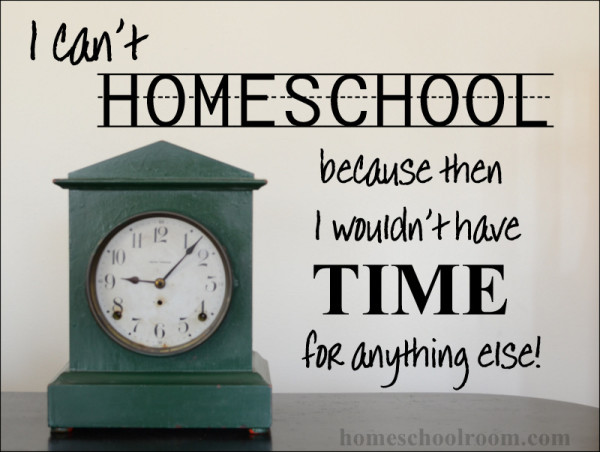
The biggest argument against homeschooling for me (you know, back when I thought only crazy people homeschooled) was “I’d teach all day then plan all night to be ready to teach the next day!” What I meant was: I can’t homeschool because then I wouldn’t have time for anything else!
Here’s what I’ve learned about accomplishing the homeschooling and household duties while still making time for me.
Accomplishing the Homeschooling
My first reality check: I don’t need to be teaching all day. I looked hard at the public school day, a schedule I was familiar with from years of volunteering. I started with their six hour school day and removed the time that the kids were waiting for the next activity or for their classmates to be ready, moving from place to place, having lunch or recess, or in independent reading time.
This is where I’d also like to put in a plug for the efficiency of homeschooling. My daughter picked up math concepts easily, but would still need to listen to more lecture and practice examples for the students who didn’t yet grasp the concept. At home, we can move right on. But I digress.
Working diligently after a prompt start in the morning we can be done our core work (and even some of the extras that don’t happen in public school) before lunch.
As far as planning all night, there are many time saving resources for homeschool teachers.
- There are open-and-go curriculum options. With some everything arrives in one box–you open the teacher’s guide and use it as directed. I won’t give specific recommendations here, because I’m not an expert in any of them. I lean towards curriculum with a bit more teacher involvement, tend to do a fair amount of tweaking, and even put together my own unit studies. Even so, an afternoon once a week is sufficient.
- Some options for home instruction are meant for the child to work through on their own. There are even computer-based programs that do the instructing. We use Teaching Textbooks for math, and this computer-based math curriculum does the lecturing and grading for me.
- Not all instruction must happen separately–a point that is especially important for large families. Other than reading, language arts, and math the rest of our subjects are done together. Many homeschool curricula give options for younger and older children.
Now that I’ve discussed the fact that it really isn’t teaching all day and having to plan all night, I’ll cover some of the other things to do that worried me before taking on this gargantuan task of educating my children.
Accomplishing Household Duties While Homeschooling
With the hours spent homeschooling, how does one accomplish housework, meal preparation, and running errands? This may be the greatest part of homeschooling. Really, I’m not kidding! Don’t think of it as “How will I get all this work done while trying to teach and plan for homeschooling?” Think of it as bringing on extra employees in the household business.
Homeschooling provides wonderful opportunities for life skills training. Public school children rush off to school in the morning, then return to find the house clean, the fridge stocked, and their clean clothes in their drawers. They often aren’t given many chores because they spend their after school time in extracurricular activities or doing homework. Instead of the household fairy doing all the work while they are gone, my children see and help with all the tasks.
- Cleaning: We have short morning chores to tidy the house, longer afternoon chores to clean something, and bigger jobs on the weekend. I put on music and call for a ten-minute tidy when necessary, instead of doing a whole-house pickup after they leave for school or go to bed.
- Cooking: Meal preparation provides practice for many skills. We start with helping to measure and stir, move to preparing easy recipes alone, and add working with heat and sharp tools. It helps the family, is a learning experience, establishes a necessary life skill, and gives them pride as others benefit from their work.
- Errands: Shopping together provides many opportunities to talk about wants and needs and financial management.
Not only does participating in these tasks help get the work of the household done, we are preparing our children for leaving our house and running their own household.
Finding Personal Time When You Homeschool
So how about all the other time a mom needs? I’ve discovered that homeschool isn’t all drudgery, and that you can–and must–make time for other things.
Though being a homeschool mom is a lot of work, I’ve learned that the work is rewarding. In addition to helping my children grow and learn, I am learning along with them! Our history, science, nature, composer, and artist studies engage my brain, too. Not to mention the great books we enjoy together!
Now for things other than homeschooling and housework–and I encourage you not to neglect these areas. It is good for your children to see that you are a person and not just a caretaker. You need time with your spouse, time with other adults, and time alone. You need time to work, pursue personal goals, or just relax. The advice to take care of yourself so you can care for others applies to homeschool moms. You do have to carve out time and make it a priority. There are several ways I structure me-time into my day.
- I take the first hour of the day to myself. Both my children know if they rise early to occupy themselves and let Mommy have her coffee. (Maybe you’re a night owl and staying up late would work better.)
- Don’t forget recess: instead of 15 minutes outside with teachers necessary to watch, I send my kids out and let them play as long as they want.
- A daily habit (and probably my favorite) is Quiet Time, a blessed hour to myself in the middle of the day.
- I also maintain bedtimes. As my children have gotten older we haven’t pushed bedtime later. We simply allow them more time to wind themselves down in bed reading or listening to audio books. Everyone benefits from these periods of quiet time in our day.
Another helpful part of our schedule is a four-day school week. This works because of our year-round schooling and gives me a three-day weekend. Here’s something I’ve noticed, too: because we’ve been working together and engaged all week, my kids are often ready to play together and work on their own personal interests.
Time with your spouse is crucial because your relationship is the foundation of the home. Early bedtimes provides time alone with my husband. We also drive an hour to Grandma’s house and the kids play with her for the afternoon while we go on dates. I encourage you to get creative if you, like us, don’t have the money for babysitters: try family members or swaps with other couples, or at the least at-home dates to give you that time with your spouse.
Time with other adults has actually been easier than I thought. I find that other moms in the same position are looking for adult interaction, too! There are many homeschool events and opportunities even in our small town. Field trips, co-ops, or simple visits are all times to socialize and support each other.
Homeschooling Is Worth It
I am happy to say I was wrong that I wouldn’t have time for anything else if I homeschooled. Not only is my time well spent, but with some creativity I carve out time for myself and my whole family is thriving in this lifestyle.
Be sure to visit iHomeschool Network, where you can be encouraged by experienced homeschoolers. Don’t believe you can’t homeschool because you’re not patient enough or organized enough, or because you don’t have a degree, or you want your kids to play sports, or you still have babies and toddlers. There are numerous myths and we’re all living proof that:
Homeschooling is possible and you can do it!
Holiday Homeschooling: Learning While Celebrating the Christmas Season
I’ve mentioned that most of our formal schoolwork takes a backseat to the many wonderful activities of the Christmas season, but do we take a whole month off from school? Not exactly. First of all, I’ve come to realize that we’re never really “off” because we never stop learning. We school year round with some periods of the year more relaxed than others. The time from Thanksgiving to Christmas is one of those times I let our formal curriculum sit on the shelves and capitalize on the learning opportunities of the season. This particular week illustrates what I mean perfectly.
Making and Baking
Any time of year I enjoy creating with my kids. It’s fun, it’s a great bonding time, and there is a lot to be learned. You can find real-world math in measuring, counting, and fractions, not to mention reading comprehension, following directions, and pride in your final product.

These are the things we created together this week:
- We made self-portrait ornaments, which may be one of my favorite homemade ornaments to date. What a fun way to capture their personality and ability at the moment!
- A Pinterest find: reindeer cookies. Ours didn’t turn out half as beautiful as the Pinterest photo, didn’t taste as good as I’d hoped, and both my kids burned themselves on the pan (despite repeated warnings from me) while trying to put the antlers on. But we had music playing and were all wearing antlers and ended up laughing over the whole process in the end.
- I had to spend half a day finishing up my Christmas shopping. To keep them from asking their Dad (who was working at home) what to do, I left them a list of some chores and more fun tasks. One was to build a Christmas decoration from Legos that I would have to find when I returned. In our Christmas village I found the Grinch and Santa’s new motorized vehicle (you didn’t know he upgraded?).
- A yearly tradition is making cinnamon ornaments. As they dry the whole house smells wonderful! It’s all the fun of rolling and cutting out cookies but easier because the dough has only two ingredients and there aren’t clouds of flour all over the place.
Performances
During the holiday season there are countless opportunities to watch and participate in performances. We’re doing both and they provide wonderful experiences. This week we attended an amazing performance of Annie, and weeks of hard work culminated in a piano recital for my daughter and church Christmas pageant for both my children.
Reading
Reading is the homeschool activity that never stops. Both independent reading and reading aloud are the backbone of not just our homeschool but our life. We have a collection of very special Christmas picture books, plus I check out an armload more from the library. Even as my kids get older the artwork and endearing stories of quality picture books are worthwhile.
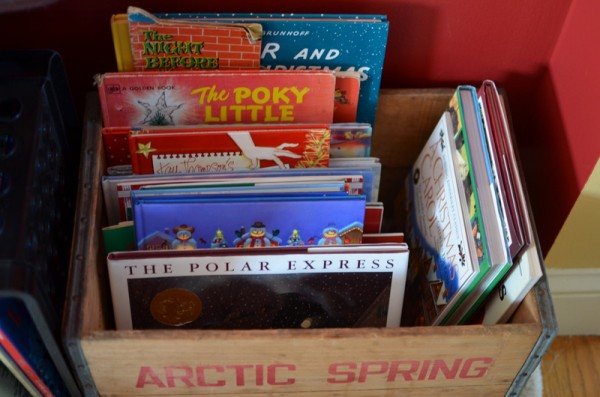
The Christmas season is a great time to take advantage of one of my favorite tools: audio books. My hands can be busy making or wrapping gifts or tidying up after a baking session, or we can keep our minds engaged while in the car running errands or driving to visit friends and relatives. Right now we’re listening to The Long Winter from the Little House series and Hello, Mrs. Piggle-Wiggle.
Writing
Opportunities abound to work on writing in a fun and relaxed way. This year my daughter is writing a holiday newsletter to send out with our Christmas card. Both kids write messages in cards and letters to Santa.
Music
Christmas music is the soundtrack of the season. This year we’re adding a study of the carols using the book Christmas Carols for a Kid’s Heart. And you can’t think about holiday music without thinking of Tchaicovsky’s Nutcracker. We did a unit study last year and attended the ballet. This year we’re enjoying the music at home, watched a production on Youtube, and used some of the ideas from the free Nutcracker Unit Study from Mary at Homegrown Learners. It was my favorite resource this week because time seems extra tight this year and her unit study had great free and easy-to-implement resources that we could use for enrichment.
Unit Studies
If we have the time and desire for something a little more formal there are some great holiday topics to be studied. We’ve enjoyed units on The Nutcracker, The Christmas Day Kitten, and the Symbols of Christmas. Homeschool Share has more than a dozen free Christmas-themed units. This year with other activities we haven’t had time to devote to a full unit study, but that’s okay!
It’s also great fun to choose another time period or country and recreate those holiday traditions. Last year we were studying colonial times in history, so it was a perfect time to focus on an Early American Christmas. There were wonderful storybooks available and countless crafts and recipes to add to our Christmas season. This year for our homeschool geography club meeting in December the country was Sweden so we learned about St. Lucia Day. My daughter brought her American Girl Doll dressed in a St. Lucia costume. (Easy to make from items we had: a t-shirt of my daughter’s pinned in the back, a pirate costume belt, mini pine garland, pipe cleaner and felt candles.)
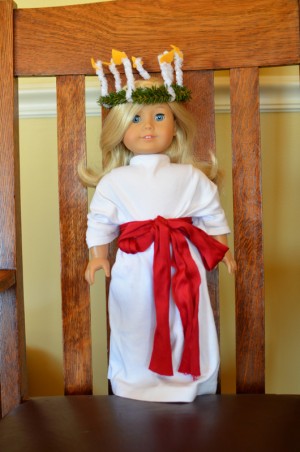
Traditions
And though it may not help with spelling words and math facts, Christmas traditions strengthen our family bonds. Our favorite this week was our Christmas lights tour. I packed a bag with surprise snacks (printable ticket thanks to Confessions of a Homeschooler–back this year by special request from my kids), we brought hot cocoa in travel mugs, and the kids wore pajamas and slippers. It’s a magical night each and every year.

So that’s how we homeschool through the holidays. We have the flexibility to enjoy the Christmas season, but the learning never really stops!
I’m linking up with these terrific hostesses:
A Day in Our Home Schoolroom
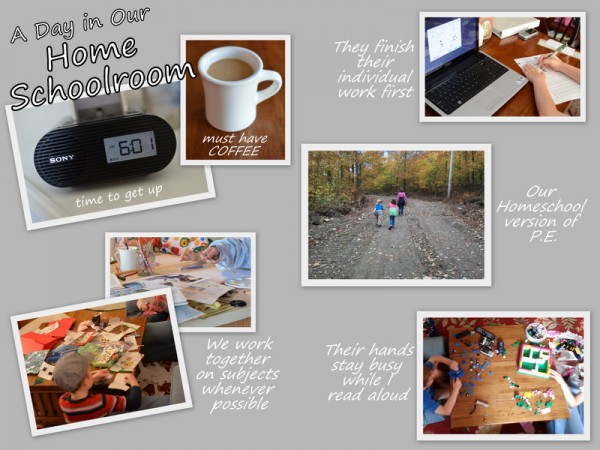
This year I’m homeschooling a first and a fourth grader. I have a little more experience under my belt and am feeling a little more confident (read: not completely terrified and overwhelmed). I find myself more and more in love with Charlotte Mason’s philosophies, but still borrowing Classical and interest-led ideas. I have settled on the amount of structure that works for us at this stage. If you’re interested you can read my post on homeschool scheduling for more on how I went from small 15-minute blocks on a spreadsheet to the schedule we use now: all our weekly goals in a list with the ability to work through them in a flexible way. I don’t have specific times on our schedule, but focus more on getting things accomplished: if math takes 15 minutes or 45, we go with it. And now, on with our day!
Wake Up:
Promptly at 6:01 my early-rising son comes into our bed. He has undoubtedly been awake for quite some time waiting for his clock to say 6:00. As soon as I can muster myself we head downstairs. He heads straight for Legos, I head straight for coffee. I feed Martha, our dog who won’t give anyone peace until she’s eaten. I am able to spend some time working: paperwork, planning, paying bills, emails, writing blog posts…
When I’ve had sufficient coffee to face the world I head out to walk Martha. We both come back ready to get rolling–me on to our school day, and Martha to flop down wherever we are and snore.

Breakfast and News:
When I return it’s time for breakfast (Dad joins us if possible). While we eat we watch CNN Student News. This is a great 10-minute news update meant for middle school to high school students, but I watch with them and I’ve only had to filter a story too old for them a couple times in over a year. We pause to explain or discuss and pull out maps to locate story areas. It makes for a lively and educational breakfast.
We clean up from breakfast and I head up to shower. The kids get ready, tidy their rooms, and complete a household chore (unload dishwasher, take out recycling). When we’re all ready it’s time for school!
Morning Meeting:
We tried variations of school morning meetings last year and they just didn’t work. Calendar activities didn’t feel like a good fit for both their ages, and I felt too repetitive and scripted. I felt we still needed some official start to our day and settled on my plan after reading a post from Barb at Harmony Art Mom on her morning routine. First we’ll have a devotion, and for that I chose The Story for Kids: Discovering the Bible from Beginning to End. I am excited to go through it with them and give them a chronological overview of the Bible’s story and message. After Bible time we’ll read poetry. Nothing fancy, just reading from anthologies we own or borrow from the library. My larger plan: they’ll memorize one poem each month, so as we’re reading they can choose their favorites for memorizing.
Individual Work:
Then it’s on to individual work! My daughter works from her weekly assignment sheet while I start with her younger brother and his reading program, as this requires the most concentration from him. I give little brother frequent changes–something requiring more concentration, then a mental break. Sometimes I’ll give him a full break to go play for a while, but often I allow him to choose from activity cards I made him last year. This was after I realized having worksheet-type activities for him didn’t suit his learning style.
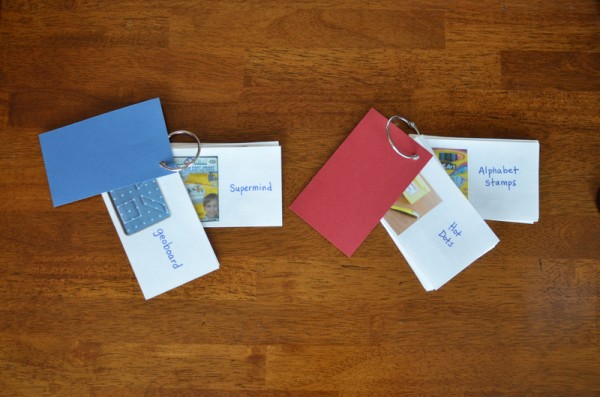
The cards simply have pictures of educational activities he can do independently. I made two sets, a red set with language arts activities and a blue set with math and science activities. During his break or card activities I work with his big sister. Writeshop and All About Spelling require one-on-one time, for other subjects I can be available to help her get set up or for questions.
Snack and Read Aloud:
After an hour or so we’ll break for a snack and read aloud time. This is a great time for books that I need them to be looking at while I read. Sometimes the choices are just for fun, but often we have books that go with our history, fine arts, nature or science studies.
After snack it’s either back to finish individual work, or starting the subjects we do together until lunch time.
Learning at Lunch:
I try to use lunch time wisely, too: we might watch an educational video or listen to an audiobook, maybe even play a game. After everyone has eaten we head outside. Some days I head out with them because I have some nature study in mind (or just need to pull a few weeds), other days I send them out to burn off some energy and enjoy nature.
Working Together:
Then it’s back inside to work together on subjects. What do we do together? As much as possible! Here’s a sort of “master list” of things that might be on my weekly planning sheet for us to work on together (click over to our curriculum for specifics):
- Science
- History
- Read Aloud: during chapter books I allow them to keep their hands busy–building Legos, knitting, drawing
- Nature Study: using Barb’s Handbook of Nature Study Blog, often involves notebooking afterward for our nature journal
- Fine Arts (using Harmony Fine Arts grade 1 Overview year–new to us and we’re very excited)
- Art: projects for fun or that go along with Harmony Fine Arts
- Handicrafts: we cook, sew, and craft whenever possible!
- Journals
- Unit studies: we’ve done units based on literature, holidays, geography, history and science
Quiet Time:
We usually wrap up by early afternoon, though often reading aloud will happen again later in the day. One thing we try to make time for every afternoon is quiet time. I was persuaded to implement this after reading about it from Tricia at Hodgepodge. We do it a little differently but it really has been wonderful. When I call for quiet time the kids gather what they need–choices are to read (including looking at books and listening to audio books for my son), write, or draw. They set themselves up wherever they would like (the current favorite chairs are pictured below) and I set a timer for one hour. During that time they need to stay put and stay quiet. We started quiet time this summer and it is a great time for all of us to recharge. Everyone comes out of quiet time refreshed and I find the rest of our day and evening are more pleasant when we’ve made time for being quiet.
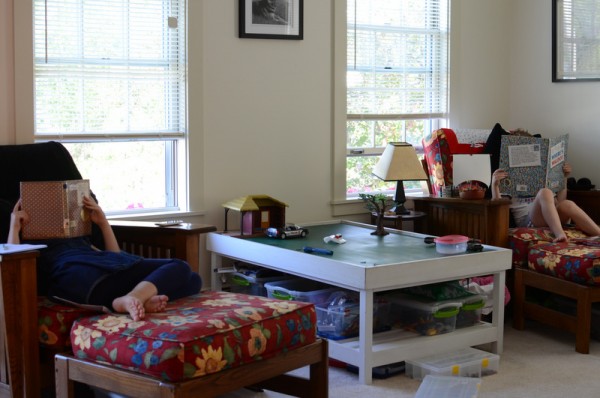
So there you have our typical “at home” day. I can be a bit uptight but am slowly learning to embrace flexibility to enjoy homeschooling. Of course like many homeschoolers we’re also involved in many outside-the-home activities: Boy scouts, Girl Scouts, piano lessons and youth group for my daughter, and gatherings with homeschool groups. We meet once a week with friends for a homeschool book club, and once or twice a month with a larger group for field trips and special events that give our kids a chance to practice public speaking, or are just for fun! I also prioritize family time–I don’t hesitate to throw out our “typical” day and take a hike, go pick apples, drive to see a lighthouse, or anything that we’re going to remember for years to come.
Thanks for joining me for a day in our home schoolroom. Be sure to check out what a day is like for other homeschoolers at iHomeschool Network’s Not Back to School Blog Hop.
Homeschool Organization: Schedules, Plans and Paperwork…Oh My!
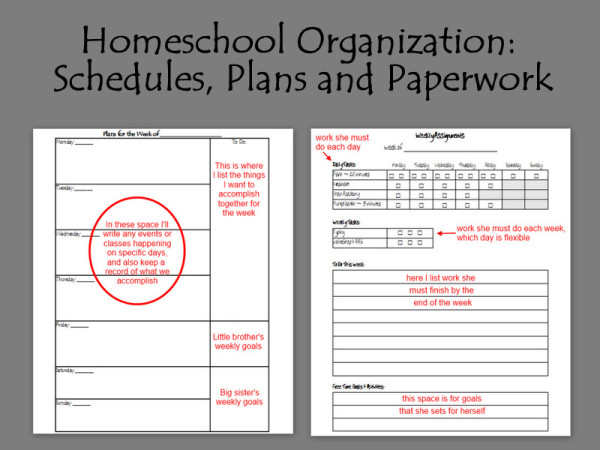 I’ve said it before and I’ll admit it again…I love lists! They make me feel organized and productive. Lists and schedules were one way I calmed my fears as we began homeschooling. I started with a detailed spreadsheet for each week, with time slots in fifteen minute increments, including a little “M” indicating who I would be working with in every block. I know, many of you are chuckling. Go ahead! I can laugh now, too.
I’ve said it before and I’ll admit it again…I love lists! They make me feel organized and productive. Lists and schedules were one way I calmed my fears as we began homeschooling. I started with a detailed spreadsheet for each week, with time slots in fifteen minute increments, including a little “M” indicating who I would be working with in every block. I know, many of you are chuckling. Go ahead! I can laugh now, too.
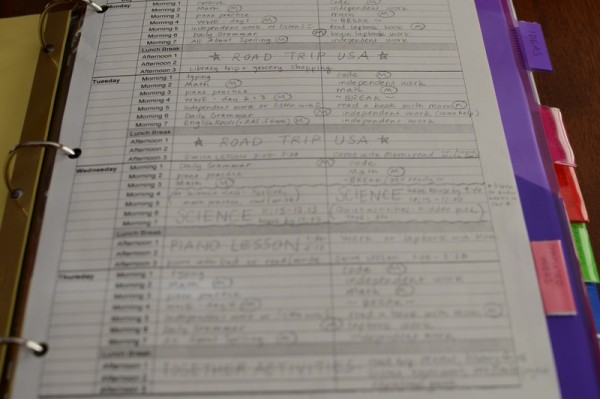
The problem was that instead of the schedule working for me, I was a slave to my schedule (dragging the kids along with me). I relaxed a little at a time until I found the level of organization that worked for me–enough to keep us on track but allow flexibility. Here’s a rundown of what I use now for planning and scheduling:
Monthly Calendars:
For our family my husband and I use Google Calendar. Yes, I fought changing to a computer-based calendar like I fight all new technology, and now I love it. We both stay up to date, and calendar alerts on my phone have saved me numerous times. Scheduled events like field trips, group meetings and classes go in Google Calendar–basically anything that requires us leaving the house.
For homeschool planning I use printable monthly calendars from Donna Young (a terrific site with loads of free resources). It’s a good place to organize my thoughts, and obviously I would clutter up Google Calendar if I added everything we do at home. Here I plan out our general school schedule: which weeks will be full time, part time or off. I write in public school schedules so we know when some of our friends are out of school. I also pencil in things like unit studies (elections/government in the fall, Christmas-related in December…) or special events we may want to celebrate or learn about.
Weekly planners:
I use two weekly planners: one for me, and one for my daughter (age 10). I made these myself in a spreadsheet program (because I already knew how to use it), and they aren’t beautiful, professional-looking forms but they are easy for me to tweak and make changes to as needed.
This is my weekly planner, and you can see I’ve relaxed quite a bit since the tiny boxes with a little “M.” I ended up with my own variation of a weekly planner from Home School Mom (scroll down to “Weekly Planner with To Do List”) with a couple changes: I plan my weeks Monday-Sunday since I usually pull things together for the week on Sunday afternoon, and I divided the “To Do” box so I would have a large area for the work we do together, and a small area for each child.
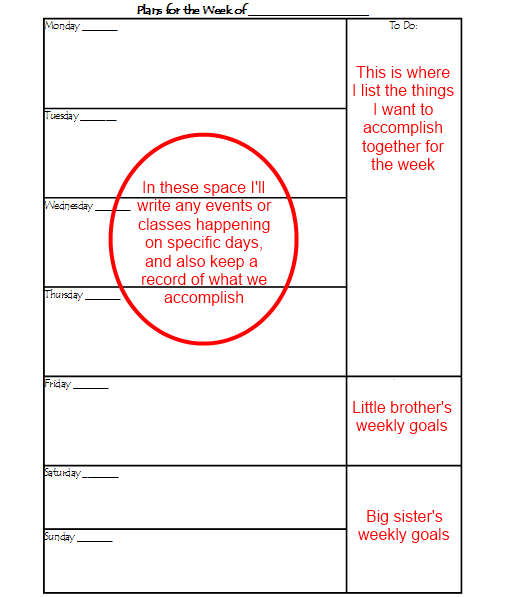
What I like best about this is the flexibility–I can still make my lists and check things off, but we can work through the weekly goals in a flexible manner. We can spend extra time reading aloud if we can’t wait to see what happens next, delve into nature study if the weather is beautiful, or break out the paint or science experiments if I don’t need to worry about the mess that day. Not only that, but it gives me permission to be flexible for the fun things (“Hey kids, Dad wants to take us out to breakfast!”) and the not-so-fun (someone just threw up) without having to scribble all over my lesson plans and schedules.
This year my daughter has her own weekly assignment sheet. Last year I began making her a handwritten list of her independent work each day so she didn’t have to ask what to do next. She enjoyed seeing what she had to do, being able to cross things off (that’s my girl!) and the independence of choosing the order of her work. For part-time summer schoolwork I made her a list for the week instead of the day and it worked even better! It saved me time (hooray!), and if something needed to carry over I didn’t have to rewrite it each day. Subjects like typing could have three check boxes, and she could decide which days to do it. I made her a printable one this year to save time and keep it neat and organized. Repeating subjects are filled in, with room to write assignments like copywork or notebooking. Note that only her individual work is there; combined subjects like science and history are not on her assignment sheet.
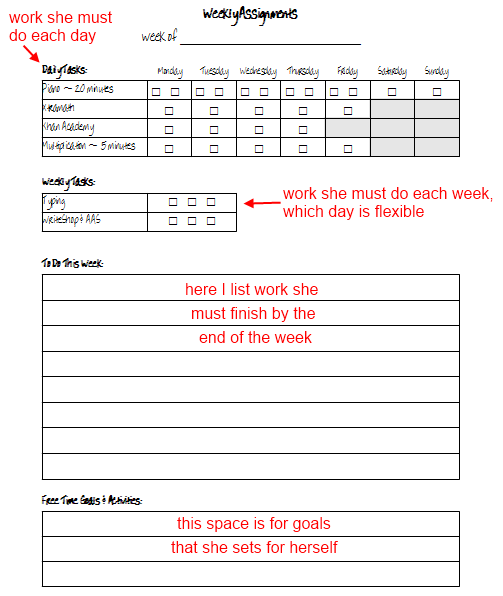
Do you notice the area at the bottom–free time goals and activities? I am excited about this one. My daughter has lots of hobbies (sewing, knitting, writing stories and piano songs), but still sometimes needs help finding things to do on her own when I’m not directing her activities. I made this area for her to do her own list-making, hoping it will help her focus so her free time can be productive.
So there you have it, my scheduling and planning paperwork in a nutshell. Now if only I could organize all the other papers that pile up in our schoolroom…
2012-2013 ~ Curriculum and Plans
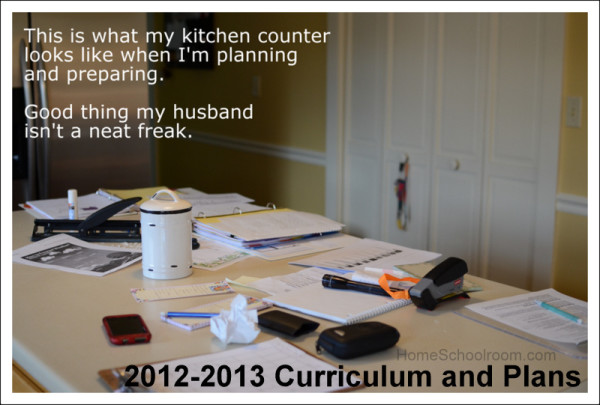
Well, here they are–my plans, dreams, and aspirations for the upcoming school year. And even though I love lists, I do try to make them in pencil and reserve the right to change them as needed!
Big Sister’s Fourth Grade Individual Work:
- WriteShop Junior D: This is a new curriculum for her and I’m very hopeful that it will be a great fit. She’s excited because it’s writing, an activity she loves, and that we’ll be working one-on-one for the lessons. There are three main goals I have for her with this program: a better understanding of paragraph structure, being able make an outline to organize her thoughts before she writes, and working on grammar within her own writing.
- All About Spelling: This curriculum was one of the hits from last year, though I would say we didn’t utilize it frequently enough to attain the full benefit. I started at level one as the program recommends and she could have gone through it much more quickly if we’d used it as often as recommended. We both liked it, though, and we’ll be diving in this year. I am planning to combine this with our work in WriteShop and block out a chunk of one-on-one language arts teaching time with her three times a week. With a year of experience under my belt and a more independent younger brother I think I can make this happen.
- Cursive Handwriting: She is capable of writing legibly in cursive, the goal now is to smooth it out and increase her speed so she can fully transition. She will be doing copywork in cursive that goes along with our history program, and I will also make more as needed using excerpts from literature we are reading and a free front called School Script Dashed.
- Math: We will continue to use Khan Academy as her math curriculum. I wanted to be sure it was the right choice for us so I did quite a bit of research over the last month. I was sure I wanted a computer-based curriculum that did not require me to plan and teach a lesson each day. After looking at all the option Khan still came out ahead for us–with the added bonus that it’s free. She enjoys the program, and with me or my husband nearby to help with any questions it works well for us. I keep an eye on the mathematics requirements in our local public school district, the Common Core standards, and Home Learning Year By Year by Rebecca Rupp to be sure she covers all necessary topics. We’ll continue to cement all math facts using XtraMath and I also have her play math apps for 10 minutes each day to work on multiplication facts. Edited to add: Okay, so plan A for math did not work at all. Short Story: we switched to Teaching Textbooks. Long story can be found in this post: Our Switch to Teaching Textbooks.
- Music: She continues in private piano lessons each week with a minimum of 30 minutes daily practice.
- Typing: She will use TypingWeb, a free web-based typing program to further her typing skills. The goal? That she can type her own stories since she can write fairly long ones!
Little Brother’s First Grade Individual Work:
- Funnix: Funnix is a computer-based learn-to-read program that is working very well for him, and I am very proud of our beginning reader! He will continue to progress through the lessons and on days we don’t do a lesson from Funnix I have him read from any beginning reader book he can tackle. Handwriting and spelling are all included in the lessons.
- Math: This was a tough subject to plan. He does not do well with a worksheet-based curriculum, which we tried last year, nor is he old enough for computer-based programs. I will use the same references I use for his big sister to determine the topics he needs to learn and we’ll tackle one skill at a time, approaching each topic in a way that suits him. It may be a hands-on game, it may be an iPad app, it may be cooking or building…this isn’t necessarily the easiest route but it’s what works best for him. (For more on this you can read my post about teaching coin recognition.)
Together Studies:
- History: We started work on Time Travelers Early 19th Century from Homeschool in the Woods. The printables (minibooks, notebooking, maps) and activities are terrific. We’ll spread this history unit study over the first half of the school year, reading lots of living books and finding documentaries to supplement.
- Science: We also started a science curriculum this summer–R.E.A.L. Science Odyssey Life Level One. It is also working well and we will continue into the school year. You can read my full review of R.S.O. We’re working on the animal kingdom now, then we’ll be slowing down as we get to the human body and really diving into that topic. I had been preparing a human body unit study (due to great interest from my son) before I received this curriculum so we’ll use R.S.O. along with other materials I’d gathered.
- Nature Study: One of the most enjoyable parts of our homeschool. We use ideas from Barb at the Handbook of Nature Study, participate in her Outdoor Hour Challenges, and also follow any interest-led nature study topics.
- Unit Studies: We will fit in unit studies as we go along based on holidays, special events (like a presidential election) and interest. I know that I want to do one on government and elections in October, and we take a break from most of our regular schoolwork in December to focus on Christmas topics.
- Other Activities: both children participate in Scouts, we will now have weekly meetings with our homeschool bookclub that met once a month last year, and big sister is in a youth group at church.
Well, it sounds like we’ll have plenty to keep us busy! The funny part is, I keep trying to plan more. I would like to incorporate composer and artist studies and am considering Harmony Fine Arts plans. I also would like to dabble in some foreign language fun–nothing too expensive or time intensive just now. But I am going to let us get rolling into our year and be happy to add/subtract and make any adjustments as we go along.
I’m linking up at the iHomeschool Network’s Not Back to School Blog Hop. Pop over there to take a peek at other homeschoolers’ plans!

2012 ~ Summer Curriculum and Plans
I hadn’t planned it ahead of time, but we ended up having a relaxed school month for June. We did fun read alouds (Matilda by Roald Dahl had us in stitches), began new journals, and kept going with nature study, but most other schoolwork took a back seat. We camped (twice), had a three-week visit from my brother-in-law who lives abroad, worked in the garden, and enjoyed many summer activities. I knew after our more rigid schedule for April and May that we would all be ready to take some time off, but I didn’t think it would be a month before I’d have my summer plans ironed out, my lists made (for myself and the kids) and be ready to dive in.
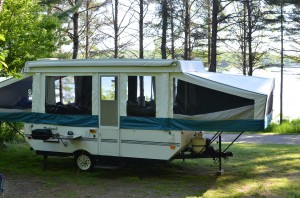
The good news? It’s July, I am ready with my plans, and it felt good to get back into a routine. My daughter cheered when I said we’d be making a minibook today, and my son ran to dress up as a pirate when I said it would be about the Barbary Pirates. That’s a good reaction for our first day back in the saddle!
Though we homeschool year-round, summer is a time we enjoy a more relaxed schedule, fitting in schoolwork around the weather and fun times camping and boating and playing with friends. Last summer we averaged about two days of school per week, broken up in chunks of a couple hours here and there. Most of what I have planned for this summer are things we’ll study together (a favorite in our house). I do have a bit of individual work for each of them just to prevent any “summer slide” in areas where that is a concern. Here’s the plan:
Big Sister’s Fourth Grade Individual Work:
- Math: She will log in to Khan Academy twice a week to work on new material and any topics that come up for review. I love how Khan automatically puts topics up for review, and has the student answer questions correctly to take it off the list! I also will have her work on Xtramath (you can read my post about Xtramath here) three times a week. We’ll keep plugging away at these math facts until they’re solid as a rock in her brain.
- Piano: No break from piano lessons (not that she would want one) so she will continue to practice 30 minutes each day.
Little Brother’s First Grade Individual Work:
- Funnix: He is making good progress as a beginning reader using the Funnix reading program so we will continue throughout the summer. My goal is 2-3 lessons a week.
- Math: Playing store and other math games to practice telling time and addition and subtraction.
Together Studies:
- History: We spent last summer studying the Revolutionary War, then backtracked a bit and studied the early explorers and Pilgrims in the fall. After that we would touch on history topics as they came up during our study of the fifty states, but history was not the focus as much as geography and modern life. I was anxious to focus on history again and though I knew the time period I wanted (post-Revolutionary War & Westward Expansion) I was unsure how to go about it. I decided on a Time Travelers unit from Homeschool in the Woods on the early 19th Century. My initial plan was to use this study just through the summer. Now that I’ve had a chance to go through it, I see there are so many wonderful topics and activities that I don’t want to rush through. I plan to add in Charlotte Mason-style living books when possible. Since it isn’t the only thing we’ll be working on I believe we’ll continue with this well into the fall. I’ll post a more thorough review of the Time Travelers unit when we’ve had a chance to work with it.
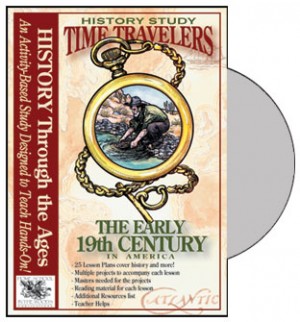
- Science: Nature Study has become an integral part of our homeschool, and a key piece of my children’s science education. We have thoroughly enjoyed and will continue using the ideas from Barb’s Handbook of Nature Study blog and her Outdoor Hour Challenges. As I mentioned in my review of our last school year, I wanted to spend even more time on science. My son has been begging me to learn about the human body, so I worked on putting together a unit study. As summer neared, our homeschool group’s science teacher quit, and I formalized my desire to cover more science basics, I decided I wanted to try an official science curriculum. I requested and received a free copy of Real Science Odyssey’s Life Level One program: the age range is perfect, it’s hands-on, and it includes a study of the human body. I’ll be posting a full review as we work with it. It is a year-long program so it should work well to start now and continue throughout the school year, especially since I plan to slow down as we hit the human body topic and use some of the other resources I’d already put together for a unit study.
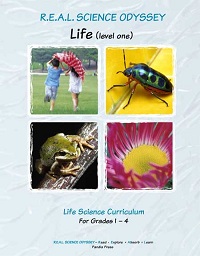
- Journals: I’d seen a great idea for a journal jar and wanted to use a similar plan. Last summer the kids wrote in journals often, but during the busier school year regular journal writing fell by the wayside. I think summer is a great time to jump back in. I didn’t print the journal prompts provided in that link, but looked through the prompts and picked the ones I liked, added a few of my own, then typed up a list of prompts and put them in a jar. They are all questions about them: likes/dislikes, special memories, plans for the future, what would you do with one million dollars, that kind of thing. I hope with the journal jar it will not only be fun, but a great keepsake for years to come.
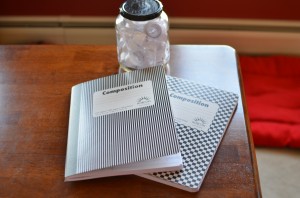
- Reading Aloud: This one is sort of a given for homeschoolers, right? In fact, we’ve enjoyed reading aloud since my oldest was a baby. But two things have placed reading aloud in the forefront for me. I’ll be doing a post on this later and let you know what two resources moved this from a filler spot to a do-first-even-if-you-don’t-get-anything-else-done spot. First on our reading list is going to be the Little House series since it’s a great go-along for our history studies. I still read picture books frequently: some nonfiction science and history books, but many just because they’re fun.
2011-2012 School Year Review…From My Kids
After all the reflecting I’d done on our homeschool year, I thought it might be interesting to get the perspective of my students, too! I remembered a post I had read last spring about getting input from your kids on Heart of the Matter. Jimmie’s advice was to ask your children questions as you evaluate your homeschool. Armed with her questions I conducted a little interview with each of my children (separately so they wouldn’t be influenced by each other). Some of the answers I completely expected, a few surprised me, and one just made me laugh.
I know math is not my daughter’s favorite subject, so I expected it to top the list on any question about what she doesn’t like. Based on the sheer amount of times she mentioned math negatively I know I have my work cut out for me. I am determined to help her see more of the value in math, and I’m hoping the book my husband and I are both reading, What’s Math Got To Do With It by Jo Boaler, will help.
Both kids listed read aloud time as their favorite part of the day, and their favorite subjects were things we do together. I wasn’t surprised by those answers, but it did reinforce for me what is already in my plan: working together on subjects whenever possible and more reading aloud. Both kids talked about wanting to spend more time studying history, which I’m excited to do as well! It is one of the subjects I am learning right alongside them.
Surprising answers included my daughter’s goal of better grammar (I’m glad I have exciting plans for that for next year), my son’s goal of learning to cook and speak a foreign language (I wouldn’t have guessed those two goals at all–and I definitely want to work on them with him). It was great to get them involved with goal planning and find out what was important to them.
The answer that made me laugh: whenever I asked my son about something he didn’t like, he asked that I “just draw a smile” because he couldn’t think of anything he didn’t like!
While our family was on a long car ride I took the time to discuss the answers with the kids and their dad. We enjoyed a nice, open discussion with everyone together. I think the biggest benefit from this exercise was showing the kids that their thoughts are important. They’re young now, but I hope we’re laying a good foundation we can build upon as they get older and take more of a role in directing their own education.
2011-2012 School Year Review
There were times this year when I felt like I’d rearranged things too often…but I tried to remind myself that the beauty of homeschooling was the rearranging: if something isn’t working I can adjust until it works! While camping on the coast of Maine just after we finished full-time school I took the time to really reflect on the year and what my plans were moving forward. Luckily, in spite of all the changes and adjustments and trying to figure things out, one over-riding truth remained: homeschooling is a great fit for our family.
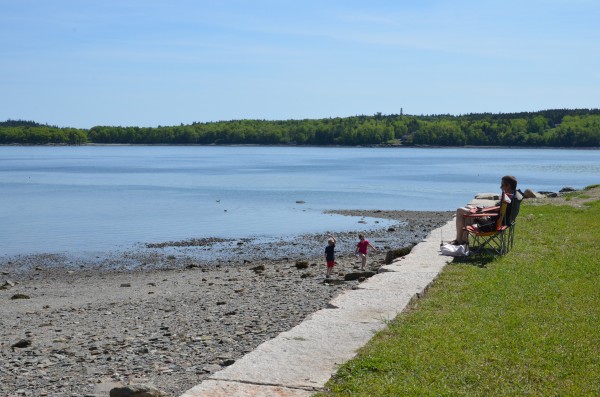
What did work this year:
- All About Spelling: My daughter and I both enjoyed this spelling program and look forward to moving ahead with it next year. The biggest bonus: I can see using it with my son when he’s ready, too. Since my children have such different learning styles, if a curriculum can be used with both of them it offers something for everyone!
- Funnix as a reading program for our son. We are so thrilled with his progress in reading and will continue through all the lessons.
- 50 States Study: This year-long study I put together from various resources was the highlight of our year. My son was actually sad when we finished the last state! We had so much fun learning about our country and its geography, history, and people.
- Nature Study: I may say this too often, but finding Barb’s site The Handbook of Nature Study blog was a God-send. I used her ideas on a regular basis and it’s a very welcome part of our school schedule.
- Working together on subjects: I will continue to combine subjects whenever possible. Both my kids are happier and still learn a lot when working together. It really becomes a bigger part of our life when we are studying the same topics.
- Homeschool book club: A friend arranged this casual group of a few homeschooling families meeting once a month, with each mom taking a turn planning the meeting. Getting together routinely with other homeschoolers was paramount to our success this year.
What did not work at all:
- Writing With Ease: At first we loved it. Then we dreaded it. Why? It felt like the same thing every day. A different piece of literature but doing the exact same thing. Once my daughter got the idea of summarizing the piece in two to three sentences I felt like it was too repetitive. So in December I dropped it, and it became the first purchased curriculum that I gave up on. At first it was disappointing, but then I felt empowered.
- Easy Grammar: This seemed okay at first, but then both my daughter and I learned something about ourselves: we are not worksheet people. This especially surprised my daughter who, coming from public school, had been overjoyed to see workbooks arriving in the mail when I began ordering homeschool supplies. I felt like it was too shallow and mixed up and that the actual teaching of grammar was missing. Plus it wasn’t carrying over into her work, so I dropped that after December. The rest of the year we focused on grammar in her own writing, making index cards with grammar rules. That worked well to some extent…but I still see room for improvement in self-editing. Stay tuned for next year’s plan, because I’m excited!
- Math Workbooks #1: Okay, so maybe we both needed to let go of our attachments to workbooks. I started both kids on Singapore Math. It took a fair amount of prep and teaching time for me, and none of us was enjoying ourselves. Mr. Technology (my husband) had been trying to show us Khan Academy and my daughter and I resisted. When we finally tried it we both loved it. I don’t see a lot of people using it as their curriculum but it works for us. I’m keeping track of the core curriculum standards and standards in our local school district so I can be sure she covers necessary topics, and I try to bring math into real life to solidify what she’s studying. Did I mention it’s also free?
- Math Workbooks #2: For little brother we did finish the Singapore Earlybird Kindergarten Book A. The problem: math concepts on paper don’t work for him. I figured that out early but thought the workbook would help keep me on track with which concepts to cover. It just wasn’t time or money well spent, though. We found computer games and apps and hands-on activities like playing store to be the best way to teach math concepts to him. Bonus: free and he is excited about playing with numbers.
What needed some tweaking:
- Science: Our weekly science class was wonderful and was where we met other homeschooling families. Unfortunately our instructor decided he had too much on his plate and he cut our class. I had already been considering supplementing at home for two reasons: science is little brother’s favorite subject, and although the class and teacher were fun and exciting, I thought my kids could use some building blocks of science that weren’t being covered. So stay tuned for next year’s plan, because I’m excited about this, too!
- My scheduling: I started off the year just a bit too uptight. I was nervous and had a schedule typed out down to every fifteen minutes. I kid you not, I had a spreadsheet that showed who was working on what, with a little “M” showing which child I was helping. Honestly, what was I thinking? That left no room for Daddy suggesting we go out for breakfast, the dog throwing up on the carpet, or wanting to play oustide after lunch because it just snowed and it’s that really good sticky snow! Not to mention if a certain subject took a little longer and the other child needed me or didn’t know what to do next. My little schedule went through several redesigns over this first school year, and I finally landed on what works for now: a simple weekly grid with nice big open boxes for each day, plus list boxes for weekly goals. I can write in something happening on a certain day (like a class or piano lesson) and then I just work away at our weekly goals in a flexible way. Maybe today the weather is nice and we’ll do some nature study. Or we feel like flopping down in the living room to finish that book. Or the kids feel like cut-and-paste crafty lapbook work. I based my schedule on this free weekly planner printable I found at The Home School Mom. I just broke up the “To Do” box on the right into three boxes: one box for together work and one for each child’s individual work.
- Tracking school days: I kept meticulous records, but didn’t have benchmarks to guide me throughout the year. I had set a self-imposed goal of finishing our required 175 days before Memorial Day and was determined to meet it. We had to work really hard in April and May to finish on time. It was worth it when we were camping the next week and knew one year was behind us, but I plan to be more prepared next year.
We’re now well into our more laid-back summer school schedule and enjoying ourselves immensely. I’ll post our summer homeschool plans as soon as I get a chance!
Year-Round Schooling

We are emphatic fans of year-round schooling. We started homeschooling when our daughter finished her year in public school, which meant we actually started in the summer at the beginning of July. It was a way to break us all into the homeschooling routine and both my kids were excited to see what it would be like. We did the equivalent of about two days a week of school, usually broken up as a couple hours here and there.
What did we do that first summer? We focused mostly on unit studies: a big one on the American Revolution and smaller ones on wildflowers and the ocean. We didn’t crack many workbooks, though my daughter did start a transition to cursive handwriting book (per her request). There was a lot of interest-led nature study as we found bugs or birds and wanted to learn more about them. Special summer activities like our library’s summer reading program couldn’t be missed, and other events like a Revolutionary war reenactment (how perfect!) or a visit to the remains of a fort once occupied by the British made perfect field trips. It was a fun summer and gave me a chance to figure a few things out. I was also amazed at how much the little bit of scheduling and doses of concentration and learning helped them do well when I wasn’t working with them. We had almost none of the “I’m bored…I don’t know what to do…” That certainly was a nice side effect! Then, after Labor Day when the public schools went back into session we still celebrated an official “First Day of School” with photos and a special breakfast. That was when we started a roughly four-day school week schedule.
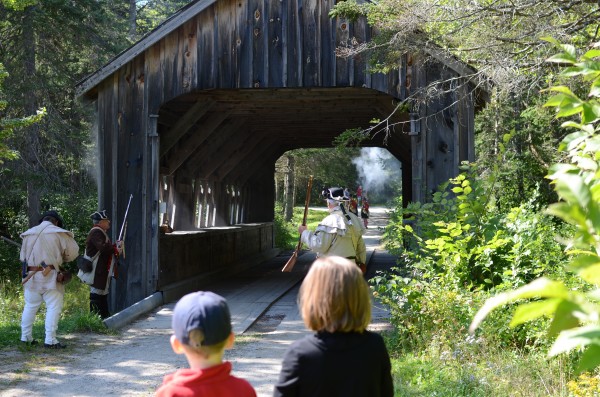
There are countless reasons this is a great fit for our family. Like I mentioned, it helps keep them engaged and prevents boredom over the summer. It eliminates the need to have drastic schedule changes that are hard to adjust to for children. It also prevents the “summer slide” children can face in math and reading over the summer. Probably my favorite part is the easing of our school-year schedule: it allows us to have a four day school week, and also take a larger break at Christmas and smaller breaks whenever we want (or need) them. Then again, perhaps my favorite part is the emphasis on learning as a life-long adventure: why would we want to stop something we love for the whole summer? Learning is exciting and fun and we would miss it!
The other piece that makes this work well for us is how I count the days. In Maine we are required to have 175 days of school per school year. I prefer counting days we do in the summer towards the next year–it makes me feel like we’re getting ahead instead of working to finish up what we didn’t get done during the school year. This is a big mental help for the kids, too. They are excited that we will finish this school year before Memorial Day (when public schools in our area still have three weeks left). The important part for them is that they will finish Kindergarten and 3rd grade so over the summer they will be working on 1st and 4th grade work. I know it is semantics really, but it means a lot to them when other kids or adults ask them what grade they are in!
I’m putting the finishing touches on our plans for this summer, so check back in for the details.



